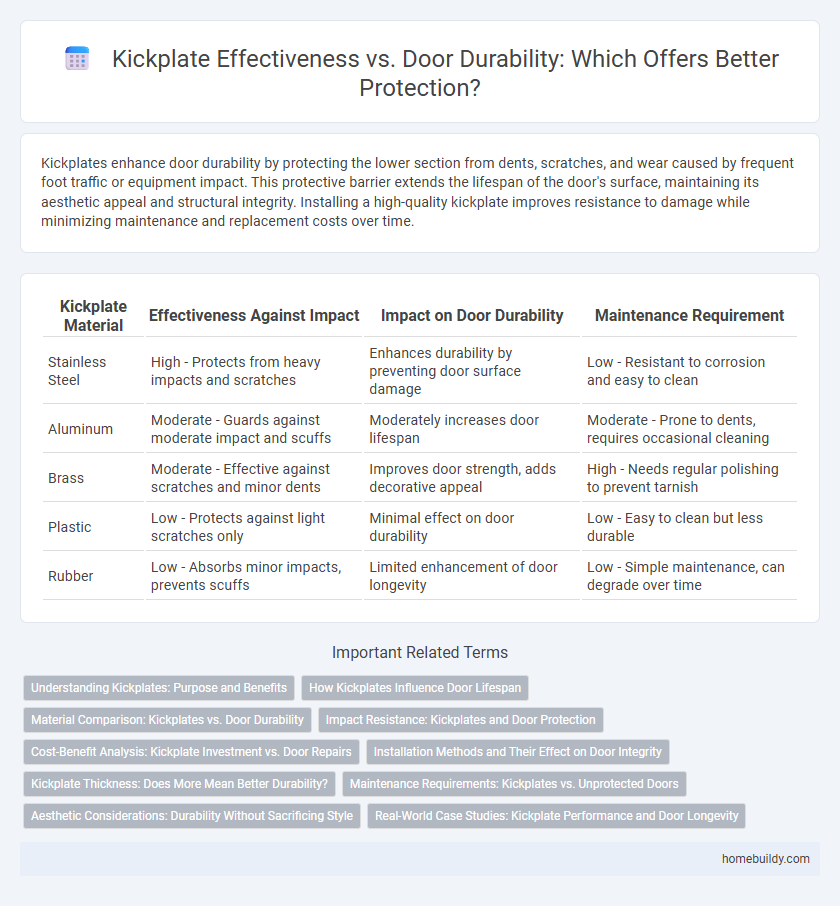Kickplates enhance door durability by protecting the lower section from dents, scratches, and wear caused by frequent foot traffic or equipment impact. This protective barrier extends the lifespan of the door's surface, maintaining its aesthetic appeal and structural integrity. Installing a high-quality kickplate improves resistance to damage while minimizing maintenance and replacement costs over time.
Table of Comparison
| Kickplate Material | Effectiveness Against Impact | Impact on Door Durability | Maintenance Requirement |
|---|---|---|---|
| Stainless Steel | High - Protects from heavy impacts and scratches | Enhances durability by preventing door surface damage | Low - Resistant to corrosion and easy to clean |
| Aluminum | Moderate - Guards against moderate impact and scuffs | Moderately increases door lifespan | Moderate - Prone to dents, requires occasional cleaning |
| Brass | Moderate - Effective against scratches and minor dents | Improves door strength, adds decorative appeal | High - Needs regular polishing to prevent tarnish |
| Plastic | Low - Protects against light scratches only | Minimal effect on door durability | Low - Easy to clean but less durable |
| Rubber | Low - Absorbs minor impacts, prevents scuffs | Limited enhancement of door longevity | Low - Simple maintenance, can degrade over time |
Understanding Kickplates: Purpose and Benefits
Kickplates protect doors from damage caused by frequent impacts, significantly extending door lifespan and reducing maintenance costs. Made from durable materials such as stainless steel or aluminum, kickplates absorb knocks and scuffs, preventing cracks, dents, and wear on door surfaces. Installing kickplates enhances both the functional durability and aesthetic appeal of doors in high-traffic areas.
How Kickplates Influence Door Lifespan
Kickplates enhance door durability by absorbing impacts and preventing scratches, significantly extending the door's lifespan especially in high-traffic areas. Materials like stainless steel and aluminum offer robust protection against wear, reducing the frequency of door repairs or replacements. Properly installed kickplates distribute force evenly, minimizing structural damage and preserving the door's original integrity over time.
Material Comparison: Kickplates vs. Door Durability
Kickplates made from stainless steel offer superior resistance to impacts and scratches, significantly extending door lifespan compared to aluminum or plastic alternatives. While aluminum kickplates provide decent protection against moderate wear, they tend to dent more easily under heavy use, reducing overall door durability. Plastic kickplates, though cost-effective, offer minimal impact resistance and wear down quickly, making them less effective in safeguarding door surfaces over time.
Impact Resistance: Kickplates and Door Protection
Kickplates significantly enhance door durability by providing a robust barrier that absorbs impact, preventing dents and scratches on the door surface. Made from materials like stainless steel or aluminum, kickplates demonstrate high impact resistance, crucial in high-traffic areas where doors face frequent forceful contact. Installing a durable kickplate extends the lifespan of doors by distributing impact energy, reducing structural damage and maintenance costs.
Cost-Benefit Analysis: Kickplate Investment vs. Door Repairs
Investing in a high-quality door kickplate significantly reduces long-term repair expenses by protecting the door's lower section from dents, scratches, and wear caused by frequent foot traffic. The initial cost of a durable kickplate, often made from stainless steel or aluminum, is considerably lower than recurring maintenance or door replacement fees, making it a cost-effective solution for both commercial and residential properties. By extending the door's lifespan, kickplates offer a favorable return on investment, balancing upfront expenditures with reduced durability issues over time.
Installation Methods and Their Effect on Door Integrity
Surface-mounted kickplates offer strong protection against impact but must be installed with corrosion-resistant screws to avoid compromising door material and integrity over time. Mortise-mounted kickplates, recessed into the door surface, provide enhanced durability by distributing force evenly, minimizing stress points that can weaken door structure. Proper alignment and screw torque are critical during installation to ensure the kickplate reinforces rather than damages the door, preserving both functionality and lifespan.
Kickplate Thickness: Does More Mean Better Durability?
Kickplate thickness directly impacts door durability by providing enhanced protection against impacts, scratches, and general wear in high-traffic areas. Thicker kickplates, typically ranging from 0.05 inches to 0.125 inches, absorb more force and prevent dents or damage to the door surface more effectively than thinner alternatives. Selecting an appropriately thick kickplate balances durability with aesthetic appeal, ensuring extended door lifespan without compromising design.
Maintenance Requirements: Kickplates vs. Unprotected Doors
Kickplates significantly reduce maintenance requirements by protecting doors from dents, scratches, and wear caused by frequent impacts, thus extending door lifespan. Unprotected doors often require more frequent repairs and repainting due to surface damage from everyday use. Installing a durable kickplate minimizes long-term upkeep costs and preserves the door's structural integrity.
Aesthetic Considerations: Durability Without Sacrificing Style
Kickplates enhance door durability by protecting lower surfaces from impact and wear, extending door lifespan without compromising structural integrity. Modern kickplates come in various materials like stainless steel, brass, and aluminum, offering high resistance to scratches and dents while complementing aesthetic styles from contemporary to classic. This balance ensures functional protection paired with a polished look that maintains the door's visual appeal in both commercial and residential settings.
Real-World Case Studies: Kickplate Performance and Door Longevity
Real-world case studies demonstrate that kickplates significantly enhance door durability by absorbing impacts and reducing surface damage, which extends door lifespan by up to 50% in high-traffic environments. Metal kickplates, particularly stainless steel variants, provide superior resistance against dents and scratches compared to plastic alternatives, proving crucial in commercial and industrial settings. Data from multiple facilities indicate doors equipped with kickplates require 30% fewer repairs, underscoring their effectiveness in maintaining structural integrity over time.
Kickplate effectiveness vs door durability Infographic

 homebuildy.com
homebuildy.com